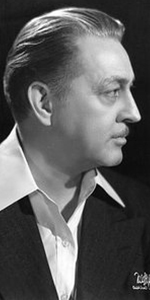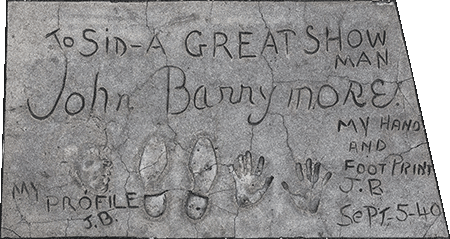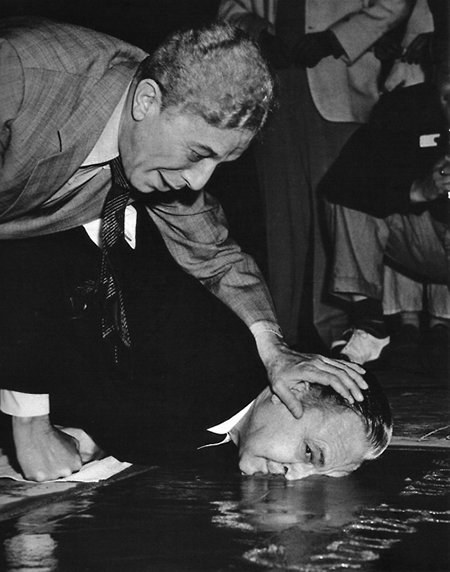 |
 |
 |
 |
 |
| John Barrymore; date uniknown |
| |
|
 |
|
 |
| |
| |
|
|
| John Barrymore
|
 |
| Forecourt Ceremony held on Thursday, September 5, 1940 |
| |
Born: John Sidney Blyth, February 14, 1882, in Philadelphia, Pennsylvania
Age at the time of the ceremony: 58
Died: May 29, 1942, in Los Angeles, California, age 60 |
| |
John Barrymore was the best-lnown stage actor of his generation. Following into the family tradition of acting, Barrymore rose quickly, starring on Broadway at a young age. Tapped to appear in pictures, Barrymore made several silent hits, then became highly regarded in early sound films, where he earned the nickname "The Great Profile."
Born into a theatrical family, "Jack" 's parents were Maurice and Georgiana Barrymore, who were both well-known stage actors. His older brother was Lionel Barrymore (1878-1954); his older sister was Ethel Barrymore (1879-1959). While he was just a baby, the Barrymore's toured the US with Helena Modjeska, then to London when he was two.
A strong-willed child, Jack was sent to a Catholic school, where he was forced to read Dante's Inferno as punishment. The Doré engravings fascinated the young man, who thereafter wanted to become an artist.
In 1892, the family matriarch Louisa Drew, lost her theatre; then Jack's mother Georgiana, died of tuberculosis. Lionel and Ethel helped with the family finances by becoming actors while in their mid-teens. Father Maurice was always on tour and rarely saw the boy.
Although he attended the Georgetown Preparatory School, he was expelled for reasons which are still unclear. Certainly Jack was already well on his way to having a drinking problem, as well as an unbridled libido. Maurice took the boy to England, where he was to study art, but la vie boheme got the better of him. When he was eighteen, he landed a job as an illustrator at the New York Evening Journal, for $50 per week.
Despite taking a role in both Maurice and Ethel's plays, Jack didn't cotton to the acting game. In 1901, he was on hand while his father became institutionalized, suffering from tertiary syphilis, and Jack was forever haunted by the fear of suffering the same fate. Fired from his newspaper job and needing money to finance his high-flying lifestyle, Jack took to the stage.
Producer Charles Frohman had Barrymore train in the hinterlands in tiny roles. He eventually appeared on Broadway in The Dictator with William Collier, who became a mentor to Barrymore, who clearly was drinking alcoholically by now. The pair toured the US and Britain in 1905; that same year, Maurice Barrymore had died.
In 1909, John Barrymore had his first starring role in A Stubborn Cinderella. Critics thought that he acted a good deal like his Uncle John Drew, but credited him with the power to improve. In 1912, Barrymore made several films for the Lubin outfit in Philadelphia, but these films are lost. In 1913, he starred in his first feature film, An American Citizen for Famous Players. His performance was so successful, that he made several more. At the urging of his new mentor
Edward Sheldon, Barrymore began appearing in heavier dramas on Broadway. Among other productions, he co-starred with brother Lionel in a production of Peter Ibbestson for over a year. In 1919, both brothers were appearing together in The Jest, which caused critics to proclaim that "the American stage has never witnessed finer acting."
Barrymore enjoyed a great success with his film version of
Dr. Jekyll and Mr. Hyde for Famous Players-Lasky in 1920. While making this film during the day, Barrymore performed Richard III on Broadway at night, receiving rave reviews, but all this landed him in a sanitarium from exhaustion. Barrymore would continue to make films and appear onstage: The Lotus Eater (released in November 1921), and Sherlock Holmes (released in March 1922), with Hamlet on Broadway and on tour.
In 1924, Warner Bros. had him play the lead in Beau Brummel
(released in March 1924). Barrymore was offered a three-picture contract, which brought more money; he also found film work "less repetitious" than acting onstage. An adaptation of Moby Dick called The Sea Beast was released in January 1926, followed by Don Juan (released in February 1927), and When a Man Loves (released in August 1927). He then signed a three-picture deal with United Artists, making The Beloved Rogue (released in March 1927), Tempest (released in May 1927), and Eternal Love (released in May 1929).
Warner Bros. offered Barrymore a five-picture deal in 1930, where he remade Moby Dick (released in September 1930), had a triumph with Svengali (released in May 1931), and had a flop in The Mad Genius (released in November 1931). After
that, he signed a non-exclusive deal to make films at Metro-Goldwyn-Mayer. He starred with brother Lionel in Arsene Lupin (released in March 1932), and appeared in the ensemble film Grand Hotel (which had its Premiere at the Chinese in April 1932).
By this time, it was becoming clear that Barrymore's days were becoming more and more clouded. They kept him busy, however: State's Attorney (released in May 1932), A Bill of Divorcement (released in September 1932), Rasputin and the Emperor (released in March 1932), Topaze (released in February 1933). His uncanny performance in Dinner at Eight (which had its Premiere at the Chinese in August, 1933), led many to believe that he would collapse on-camera.
After that, Barrymore made two more pictures before suffering another breakdown: Counsellor at Law for Universal (released in December 1933), and 20th Century for Columbia (released in May 1934). A much-publicized romance with a 19-year-old dealt Barrymore a severe blow to his self-image. His role as Mercutio in Romeo and Juliet (which played the Chinese in May 1937), was well-received, but news of his on-set disruptions spread throughout the industry.
Barrymore dried out for a period, producing condensed versions of Shakepeare for NBC radio called Streamlined Shakepeare in 1937. He was so well-behaved that film offers came in: True Confession (released in December 1937) and Marie Antoinette (which played the Chinese in October 1938), and The Great Man Votes (released in January 1939).
His supporting performance in Midnight (released in March 1939) simply must be seen — a classic.
To promote his next-to-last film, The Great Profile, Sid Grauman had him out to the Chinese for a Forecourt ceremony. It was only natural that Grauman would suggest having Barrymore place his great profile into the cement.
The film would open at the theatre the following week — to devistating reviews.
While recording lines for Rudy Vallée's radio show, Barrymore collapsed, was rushed to hospital, and died of cirrhosis of the liver at the age of 60. |
|
|
|
|
| |
 |
 |
| Grauman's Chinese Theatre, Hollywood, California. John Barrymore Forecourt block. Executed by Jean Klossner, Thursday, September 5, 1940. 66 x 35 inches overall. |
 |
 |
 |
| Grauman's Chinese Theatre, Hollywood, California. John Barrymore Forecourt ceremony, Thursday, September 5, 1940. Sid Grauman pushes John Barrymore's "great profile" into the cement. |
|
|